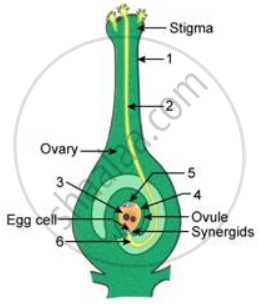Advertisements
Advertisements
Question
Can an unfertilised, apomictic embryo sac give rise to a diploid embryo? If yes, then how?
Solution
Yes, if the embryo develops from the cells of nucellus or integument it will be diploid.
APPEARS IN
RELATED QUESTIONS
Double fertilization is reported in plants of both, castor and groundnut. However, the mature seeds of groundnut are non-albuminous and castor are albuminous. Explain the post fertilization events that are responsible for it.
What are the advantages of the following in the flower to the plant concerned?
Smooth and light pollen
What is the function of the pollen tube? Explain it with the help of a diagram.
Given ahead is a diagrammatic representation of the process of fertilization. Study the same and then answer the question that follows:

What happens to
i) Ovary
ii) Ovule after fertilisation
What is ‘double fertilization’? Describe it with the help of a neat and well-labeled diagram. Give its importance.
Explain the pollination process in maize.
What is a fruit?
Give any four points of significance of double fertilization.
The seed is a fertilized _______.
Match the following
| I) | External fertilization | i) | pollen grain |
| II) | Androecium | ii) | anther wall |
|
III) |
Male gametophyte | iii) | algae |
| IV) | Primary parietal layer | iv) | stamens |
Syngamy results in the formation of ______.
Write a short note on Pollen kitt.
Identify the CORRECT statement with reference to cellular endosperm.
If the cells of the nucellus in the angiosperm ovule contain 24 chromosomes, then ____________ chromosomes will be present in the endosperm of a self-pollinated flower.
In a fertilised embryo sac, the haploid, diploid, and triploid structures are ______.
Double fertilization is a distinctive feature of ______.
Name the part of gynoecium that determines the compatible nature of pollen.
Which is the triploid tissue in a fertilised ovule? How is the triploid condition achieved?
What is the function of the two male gametes produced by each pollen grain in angiosperms?
Select the option that shows the correctly identified 'U', 'X', 'Y' and 'Z' in a developing dicot embryo.

